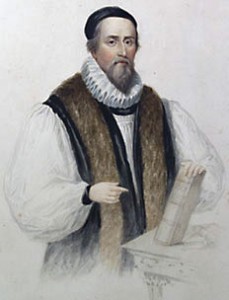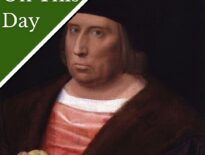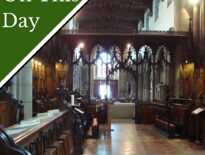 On 15th March 1554, in the reign of Queen Mary I, John Hooper, Bishop of Gloucester and Worcester, was deprived of his bishopric while imprisoned in Fleet Prison.
On 15th March 1554, in the reign of Queen Mary I, John Hooper, Bishop of Gloucester and Worcester, was deprived of his bishopric while imprisoned in Fleet Prison.
Hooper had been charged with owing over five hundred pounds in unpaid first fruits, a charge he denied.
Let me tell you a bit more about this man, who ended up being a Marian martyr…
- John Hooper was born in Henry VII’s reign, at some point between 1495 and 1500.
- His background and early life are obscure, but it is thought that he came from either Devon or Oxfordshire.
- He was educated at Oxford, graduating with a BA in 1519, before joining the Cistercian order of monks at Cleeve in Somerset.
- Hooper probably left the monastery in 1537 following its visitation by commissioner Sir Thomas Arundell as part of the dissolution of the monasteries, and he became rector of Liddington Church in Wiltshire, while also serving as steward to Arundell.
- His conversion from Catholicism to Zwinglian-style Protestantism appears to have happened during his time working for Arundell, when he read works by Reformers Zwingli and Bullinger. However, Arundell was a conservative and so Hooper was sent to Stephen Gardiner, the conservative Bishop of Winchester, for correction. After a few days with Gardiner, Hooper, who feared for his safety, managed to escape and possibly fled to Paris for a time.
- He then worked for reformist Sir John St Loe, Arundell’s nephew, who was Constable of Thornbury Castle, before having to flee into exile again in around 1544, settling eventually in Zurich. He married a Belgian woman, Anne or Anna de Tscerlas, while in exile and they had two children together, a boy and a girl.
- In Zurich, Hooper became good friends with Bullinger and he also published three religious works: An Answer to my Lord of Wynchesters Booke Intytlyd a Detection of the Devyls Sophistry (1547); A Declaration of Christ and his Office (1547); and A Declaration of the Ten Holy Commandments (1548).
- Hooper returned to England in May 1549 and joined the household of Edward Seymour, Duke of Somerset and Lord Protector. He also preached in London, becoming popular, and was active in the founding of churches in the city and also in Glastonbury, in Somerset for Dutch and French refugees.
- In 1549, Hooper was a witness for the prosecution in the trial of Edmund Bonner, Bishop of London, who was deprived for his bishopric.
- Hooper survived the fall of Somerset and preached at the royal court, in the presence of King Edward VI, during Lent of 1550. The king offered him the post of Bishop of Gloucester, but he refused because of his objection to the oath concerning saints and the required vestments, the wearing of which, he believed was not scriptural. Due to the vestments controversy, as it came to be called, and his arguments with Bishop Nicholas Ridley, Hooper ended up being confined at Lambeth Palace, the Archbishop of Canterbury’s residence, and then in the Fleet prison. He was released after his friend Bullinger intervened, persuading him that the issue just was not worth his opposition, and he submitted. He was consecrated as Bishop of Gloucester in vestments in March 1551.
- In his role as bishop, Hooper set about a visitation of his diocese and plans for reform. His biographer, D. G. Newcombe, explains that he took with him “ fifty articles of religion, thirty-one injunctions, twenty-seven interrogatories to be asked of the clergy, and sixty-one interrogatories to be asked of the laity” and that “These articles and interrogatories served as the foundation for Hooper's programme of reform within the diocese and went beyond anything seen before, anywhere in England”.
- In 1552, Nicholas Heath, Bishop of Worcester, was deprived of his office and Worcester became united with Gloucester. Unfortunately, Hooper’s reforms weren’t as welcome in Worcester!
- In the succession crisis of July 1553, Hooper supported Mary’s claim, but, just a month later he was called before the privy council and charged with owing over five hundred pounds in unpaid first fruits. He denied it and put in a counter claim for £80, but he was imprisoned in the Fleet. The problem was, of course, his faith, not his debt.
- Hooper’s family fled into exile to Frankfurt, but sadly Anne and their daughter, Rachel, died during an outbreak of plague in Frankfurt in late 1555. It appears also that their son, Daniel, died young.
Hooper was deprived of his bishopric on 15th March 1554 and he was tried in January 1555. He was executed by being burnt at the stake on 9th February 1555. He suffered a long burning due to green wood being used and the wind. Here's my video on his execution:
Image: A hand-coloured stipple engraving of Bishop John Hooper by Henry Bryan Hall, after James Warren Childe.



I found the article very impressive and thought-provoking.
I still confused that there is a statement in wikipedia “John Hooper, having been exiled during King Henry’s reign” what is/are the reason he fled to the Continent? I am from Indonesia